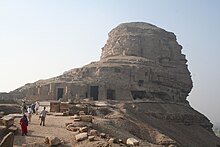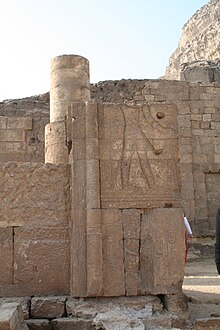Tihna al-Jabal
Coordinates: 28 ° 11 ′ 20 ″ N , 30 ° 46 ′ 10 ″ E
Tihna al-Jabal ( Arabic طهنا الجبل, DMG Ṭihnā al-Ǧabal , also Tehne , Tehna or Akoris ) is a place and an archaeological site in Middle Egypt ( Egypt ) twelve kilometers northeast of al-Minya east of the Nile. The village is located west of the limestone mountains at the mouth of Wadi Tihnawi ( Arabic الوادي الطهناوي, DMG al-Wādī aṭ-Ṭihnāwī , the wadi of Ṭihnā '), whose southern rock is reminiscent of a reclining lion.
history
The area of the village and the terrain in its south had been inhabited since the ancient Egyptian Old Kingdom . The village had several names (ancient Egyptian Mer-nefer (et) ("Beautiful Canal", Old and Middle Kingdom), Per-Imen-mAt-chent (j) ("The house of Amun, the foremost lion", New Kingdom) , TA-dehenet ("the mountain peak", from the 26th dynasty), Greek Ἄκωρις (Akoris, Latin Acoris) and Τῆνις (Tēnis)).
The ancient Egyptian settlement was at all times an important administrative city in the south of the 17th Upper Egyptian Gaus . It probably also had a port. Archaeological evidence has only existed since the New Kingdom with the Temple of Amun . Today's settlement remains south of the village date back to the Roman-Coptic period. Perhaps because of the strategically favorable location there has also been a fortress here since Persian times, but this cannot be proven archaeologically.
The gods had a strong local connection with the rocks or the wadis. The deity worshiped here in the early days is unknown, perhaps it was a lion deity. From the 18th dynasty onwards, Amun , the foremost lion, is worshiped here. From the 26th dynasty, Sobek , lord of Beẖ (et) (lord of the mouth of the (desert) road), was added and became the main deity. Other gods worshiped here were Thoth , Isis and / or Mut , Osiris , Horus and Chons .
Tombs have been dug in the rock since the middle of the 4th Dynasty. Some of these are large chamber graves of the wealthy administrative officials; the most famous are the Fraser graves . In the 21st and 22nd dynasties, the graves of the priests of the local temple were also buried here. From the New Kingdom onwards, some of the early graves were rededicated in chapels for Amun and later also for Sobek. The graves were all plundered.
Monuments
Only a few ancient Egyptian monuments have survived. You are in the south of today's village.
The Temple of Amun, King of the Gods (also known as Temple B) comes from the New Kingdom. He was created in a chamber grave under Ramses II and under Ramses III. completed. At that time it was a pure rock temple ( Speos ), it consists of four consecutive chambers with an altar in the last chamber. The first chamber had the original grave shaft. The temple was significantly expanded in the time of Nero , it now received an access path and a hall with eight pillars in front of the rock hall. Only the entrance to the pillar hall is decorated with depictions of the sacrificing King Nero. On architrave fragments, Sobek, Thoth Isis or Mut in sacrificial acts of Nero (or Germanicus ) could still be seen.
Immediately south of the Temple of Amun is the Temple of Sobek, Lord of Beh , from pre-Ptolemaic times (also called Chapel or Temple C). It was also placed in a large chamber grave, of which remains of piers with the image of Hathor are still present. These four pillars were placed around the grave shaft. This temple has no other decoration except for an inscription on the door jamb that names the revered god. The statue niche is at the back.
In the foreland of the temple you can see the remains of the Roman settlement .
A little further south is the rock stele of Ramses III. showing the Pharaoh in front of Sobek-Re accompanied by Amun, Lord of Shana. The Fraser graves are located about two kilometers south .
Quarries
The area was and is also used as a quarry for the white, calcified nummulite limestone that was formed from the calcium deposits of single-celled, shell-bearing amoeba living in the sea in the Tertiary.
literature
- Hans Bonnet : Akoris. In: Lexicon of Egyptian Religious History. Nikol, Hamburg 2005, ISBN 3-937872-08-6 , p. 13.
- Dieter Kessler: Historical topography of the region between Mallawi and Samaluṭ. Reichert, Wiesbaden 1981, ISBN 3-88226-078-5 , pp. 253-290.
- Rosemarie Klemm , Dietrich D. Klemm : Stones and quarries in ancient Egypt. Springer, Berlin a. a. 1993, ISBN 3-540-54685-5 , pp. 88-91.
- Labib Habachi : Three Large Rock-Stelae Carved by Ramesses III near Quarries. In: Journal of the American Research Center in Egypt. (JARCE) Volume 11, 1974, pp. 69-75 (in English).
- Richard Pietschmann : Akoris 1 . In: Paulys Realencyclopadie der classischen Antiquity Science (RE). Volume I, 1, Stuttgart 1893, column 1186.





